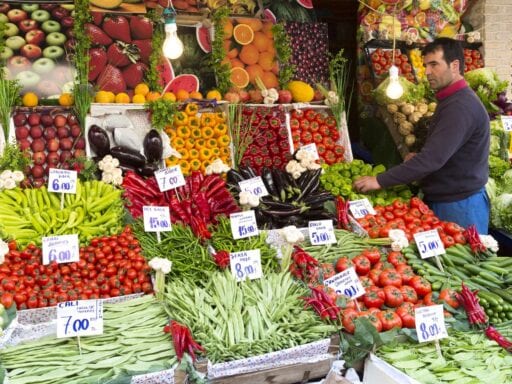The answer is not “eat local.”
“Eat local.” It’s a recommendation you’ve probably heard before. Environmental advocates and even the United Nations have hyped a “locavore” diet as a way to reduce your carbon footprint and help the climate. The basic idea is that more transportation leads to more emissions, so you want to reduce the distance your food has to travel to get to you.
And certainly, if you can eat local, that’s great. But it’s not the most effective way to reduce your food’s carbon footprint.
The website Our World in Data recently explained, with some great charts, why your focus should really be elsewhere.
“Eating locally would only have a significant impact if transport was responsible for a large share of food’s final carbon footprint. For most foods, this is not the case,” writes Hannah Ritchie. “Emissions from transportation make up a very small amount of the emissions from food and what you eat is far more important than where your food traveled from.”
Take a look at the chart below, which examines 29 different food products, from beef to nuts, and breaks down how much greenhouse gas emissions each stage in the supply chain is responsible for. The data comes from the biggest meta-analysis of worldwide food systems we’ve got so far, published in Science in 2018.
/cdn.vox-cdn.com/uploads/chorus_asset/file/19731211/carbon_impact_of_food.jpg) Our World in Data
Our World in DataAs you can see, the share of emissions from transport (shown in red) is generally pretty tiny; the distance our food travels to get to us actually accounts for less than 10 percent of most food products’ carbon footprint. Processes on farms (shown in brown) and changes in land use (shown in green) typically account for much more of the emissions from our food.
Translation: What you eat is much more important than whether your food is local.
So, next time you find yourself trying to choose between a couple of different dinner options — local prawns versus non-local fish, let’s say — remember that from an emissions standpoint, the fish is the better choice even though it comes from farther away.
One caveat: Although transport has a small climate impact for most food products, that’s not true for products that travel by air. Now, very few products actually fall into that category — just 0.16 percent of food is air-freighted, while the vast majority travels by boat (including those beloved avocados). But it’s worth noting which products do travel by air, and avoiding them when they’re not in season, since air travel is so bad for the climate.
It can be hard to know which products in your grocery store are air-freighted, since they’re almost never labeled as such. But a good rule of thumb is to avoid fresh fruits and vegetables that have a short shelf-life and that come from far away (check the label for their country of origin). Berries, green beans, and asparagus are examples of foods that are often air-freighted. Locally sourced berries, green beans, and asparagus, though, have a low carbon footprint.
What about “sustainable meat” versus plant-based foods?
At this point, you might be wondering where plant-based foods fit into all this. With so many grocery stores and restaurants now selling Beyond Meat and Impossible Foods, it’s reasonable to wonder about the carbon footprint of products made from protein sources other than meat.
Some have argued that you can have a lower footprint if you eat beef or lamb sourced from low-impact producers than if you switch to plant-based alternatives. But the evidence suggests that’s just not true. (Remember that only 0.16 percent of food is air-freighted, and that figure includes fruits and vegetables.)
“Plant-based foods emit fewer greenhouse gases than meat and dairy, regardless of how they are produced,” Ritchie writes.
Here’s another chart, which shows that less meat is nearly always better than sustainable meat when it comes to reducing your carbon footprint. The data comes from the same 2018 meta-analysis mentioned above, which considered the food systems in 119 countries.
/cdn.vox-cdn.com/uploads/chorus_asset/file/19731220/Carbon_footprint_of_protein_foods_2.jpg)
As you can see, beef and lamb are way over on one extreme in terms of the amount of emissions they produce. By contrast, plant-based protein sources like tofu, beans, peas, and nuts have a very low carbon footprint.
“This is certainly true when you compare average emissions. But it’s still true when you compare the extremes: there’s not much overlap in emissions between the worst producers of plant proteins, and the best producers of meat and dairy,” Ritchie notes.
Translation: Eating plant-based food is almost always going to be better for the environment than eating even the most sustainable meat.
That said, it’s worth noting that some types of meat are much harsher on the environment than others. Replacing beef or lamb with chicken or pork — again, regardless of where you get the products from — is an effective way to reduce your carbon footprint.
This is all coming strictly from an emissions standpoint, mind you. It doesn’t take into account animal welfare. Perhaps you think the welfare of animals like pigs, which show signs of high intelligence, is an important consideration here; if so, you might think it’s a bad idea to substitute pork for other types of meat. And we have to slaughter about 200 chickens to get the same amount of meat we’d get from one cow, which raises environmental as well as animal welfare concerns.
There are multiple factors to consider when making food choices, and your final decision may shake out differently depending on how you weight each of them.
Sign up for the Future Perfect newsletter and we’ll send you a roundup of ideas and solutions for tackling the world’s biggest challenges — and how to get better at doing good.
Future Perfect is funded in part by individual contributions, grants, and sponsorships. Learn more here.
Author: Sigal Samuel
Read More



